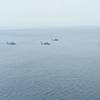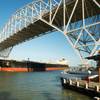All ship’s systems are vitally important to the success of the Navy mission, so whom does the captain call when a gas turbine stops turning? What happens when a diesel engine aboard ship breaks down?
Until recently, Navy tenders handled most shipboard maintenance when the ships returned to homeport. Many tenders have been selected for decommissioning requiring the Navy to find new solutions to the age-old problem of ship maintenance and a key element is the Navy Afloat Maintenance Training Strategy (NAMTS) program.
"What drove this program is tender decommissioning," says Chief Machinist Mate Kevin Krepps, command coordinator for Job Qualification Requirements at Pearl Harbor Naval Shipyard and Intermediate Maintenance Facility. Through the NAMTS program Navy petty officers with fleet experience acquire the skills necessary to perform maintenance on a variety of ship systems, including hydraulics and electrical components.
Sailors arriving at Local Training Authority Pearl Harbor are screened for current repair qualifications and Navy Enlisted Classification (NEC) codes. Most are second and first class petty officers. "Second and first class petty officers are the meat and potatoes of it - people with fleet experience," says Krepps, a submarine warfare qualified Sailor himself.
Most training is driven by work that is already present, though some specialized training does fall outside normal workshop duties. During this on-the-job training the Sailor completes a qualification card as skills are demonstrated under the supervision of a qualified mentor. "The Sailor is overseen by a senior military or civilian employee who knows the ins and outs of each skill," says Krepps. "This gets highly qualified people out to the fleet."
Once a student completes a program that Sailor earns a new NEC code that designates an area of expertise. Assigned to a ship in the battle group the Sailor joins the battle force Intermediate Maintenance Activity pool of maintenance specialists. "So when something in the battle group breaks, they look up the NECs and find the person they need with the skills needed within the battle group," says Krepps.
Over the last five years, approximately 64 Pearl Harbor Sailors have completed specialized in-rate training through the NAMTS program in support of the Battle Force Intermediate Maintenance Activity. Hull Technician First Class Mark Francalangia, whose former commands include USS Peterson (DD 969) and USS Fulton (AS 11), recently completed the local sheet metal training program and received his new NEC. Along with the skills he acquired as a sheet metal worker, Francalangia hopes his training will lead to advancement opportunities as well as other possibilities. "This is not just another qualification; it could have benefits. I would love to get the call to go to, say, Yokosuka, Japan, to fix a problem." It would be a problem Francalangia may be uniquely qualified to fix with his newly learned skills.
Francalangia feels that training is very important to the fleet and should be taken seriously by all those involved. "As leaders we need to be sure our people get the right signatures and the right training that they need," says Francalangia. But filling a qualification card with signatures is not enough. Both trainers and trainees must take their training seriously. "Take the time to strategically set up a training program and make sure those who give the signatures are accountable," says Francalangia.
Of NAMTS, Francalangia says, "It’s a program for go-getters, and they can feel good about qualifying." This is certainly true of Francalangia, who has recently begun a second training program as a ship fitter.
Navy programs like NAMTS help the fleet achieve its mission by providing battle groups with trained personnel capable of handling a variety of maintenance challenges. In Krepps’ words, "The result is a win for the Navy from all standpoints. A better-trained Sailor means that the fleet not only operates at a higher level of excellence; but the shipyard as well."
Source: Navy News Service (NNS).
Subscribe for
Maritime Reporter E-News
Maritime Reporter E-News is the maritime industry's largest circulation and most authoritative ENews Service, delivered to your Email five times per week










